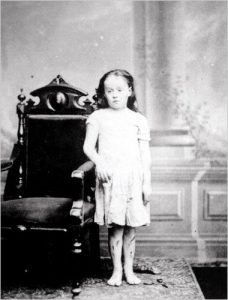Winner of the Spring 2018 StMU History Media Award for
Best Article in the Category of “Crime”
Article with the Best Introduction
In today’s society, we are taught at a young age to never speak to strangers without our parents around or by ourselves in general. However, in the late 1920s, it was a different time of danger and being more aggressive in hate crimes and violence. Sadly, those “norms” would erupt in a rise of terror and isolation within Brooklyn, New York. On February 11, 1927, two boys, Billy Gaffney and Billy Beaton, were having fun within their apartment, unsupervised. A few hours passed, both boys could not be found, until someone found Billy Beaton alone on the apartment roof. When asked where Billy Gaffney had gone, he responded with, “The boogey man took him.”1
This “boogey man” who took Billy Gaffney was indeed one’s worst nightmare. Calling him a man certainly does not do justice to the true monster that this “boogey man” Albert Fish was. At fifty-six years old, Albert Fish already had quite a life before that February day in 1927. He had been born on May 19, 1870 in Washington D.C. Originally named Hamilton Fish, Albert was the youngest of his three siblings. However, Fish had no clue as to who he would become. He was raised in a family whose members had mental health issues. His family was mostly illiterate, and to make matters worse, his own mother, when he was at the age of five, put him in an orphanage due to financial problems. Albert’s time in St. Johns Orphanage sparked a dangerous set of behaviors. He was frequently abused and beaten at the orphanage, but he soon developed something of an enjoyment of the feeling of physical pain, often giving him erections.1 In 1879, Albert’s mother was back on her feet financially and able to support Fish again. But Fish went from the abusive environment of the orphanage to a crowd of neighborhood youths who introduced the nine-year-old Fish to the practices of drinking urine, as well as to coprophagia (the act of eating feces or dung). He also started visiting public bath houses to watch young boys undress. Poor Fish’s mother had no idea that in her absence, her son was developing disturbing behaviors.
By 1890, twenty-year-old Fish had moved to New York City. In this part of Fish’s life, his behaviors escalated to rape, sodomy, and then to castration, mostly on male individuals of lower social status, such as African-American males and disadvantage males whom he believed would not be missed.3 He continued his acts of complete horror even after being arranged into a marriage in 1898 with his wife.4
During his marriage, he and his wife had six children together. He never abused his own children in any way, but he did became a house painter and usually targeted homes with young boys aged around six and continued with molestation and a morbid and horrid interest in castration.5 He was then incarcerated in 1903 for embezzlement, which then led to Fish regularly having sex with men in prison. However, his actions led to his divorce from his wife in 1917, who left him for a handyman named John Straube, and taking all of their children. That only made Fish become more sunk into a hole of obsession and terror.6 He began having morbid and frightening thoughts, and developing cravings such as cannibalism in which he enacted upon his victims in murdering them. Surprisingly, he had never been caught committing any of these murders, and if he were ever close to getting caught, he would flee the city. That is, up until Fish made a big mistake, which later helped solve the mysterious disappearance and murder of Billy Gaffney. This was possible through the unfortunately more famous case of the murder of a young girl, Grace Budd.

Grace Budd was an eleven-year-old girl who lived in a farmhouse with her brother, mother, and father. In a newspaper advertisement, Albert Fish found a man by the name of Edward Budd looking for a job. Fish then marked Edward Budd to be his next victim.7 Soon after, Fish responded to the newspaper ad by posing as a wealthy farmer named Frank Howard in need of help on his farm, and he began to be friendly with the Budd family.8 Fish’s plans, however, had switched after he discovered Edward Budd had a younger sister Grace, who seemed to be far more vulnerable than Edward had been. This is when Fish began to create a disgusting and horrible scheme to capture the young Grace Budd. Fish convinced the parents to let Grace accompany him to his sisters’ birthday party, which he completely fabricated.9 Fish took Grace and she never returned home after that day. Only after seven years, on November 11, 1934, were the details to what had happened to innocent Grace discovered. Fish sent a letter to the parents of Grace Budd detailing what he had done to her.8 To their horror, he confessed that he cooked parts of her to taste her flesh. He detailed her last moments, describing the torture and truly horrid acts Fish had committed upon her before Grace Budds’ final moments on earth. One would hope that Fish would end the letter on that horrifying and heart breaking note; however, he then described the process of preparing her body to feast upon, the parts of the body he had used, the taste of their daughters’ flesh and how he found her taste so satisfying. He then included at the end of the letter how he left her a virgin, as if that would lighten the terrible acts that he had committed on the young and innocent Grace Budd and her family.11
It was only through this tragic incident that justice came about for Albert Fish’s horrendous act of murder. Fish’s letter to the Budd family was just enough evidence to find and capture him. Detective William King helped track down and arrest Albert Fish using symbols on the stationary he used to write to the Budd family, “N.Y.P.C.B.A.” standing for “New York Private Chauffeur’s Benevolent Association.” King successfully located where it had come from, tracing it back to a room at 200 East 52nd Street from a janitor who had moved from there. This location was the exact place where Fish came frequently to receive his mail. Finally, this helped investigator William F. King pinpoint exactly where Albert Fish would be; waiting right outside of his room.12

Fish was captured and taken in for questioning. During questioning, Fish admitted to murdering Grace Budd and confessed to the investigators exactly where he had buried the remains of Grace Budd. They were able to locate Grace Budd’s bones, which were located behind Wisteria Cottage, an abandoned house in Westchester County. Fish then confessed to eating parts of Budd’s body, as well as to the murder of Billy Gaffney, including the torment he had done to Billy.8 After Fish’s arrest, he did not care for the consequences and looked very much forward to having his penalty be death. In March 1935, Fish pleaded sane but guilty.14 The court decided that he was sane, and accepted his plea of guilt.15.

Fish was executed on January 16, 1938 in the electric chair in Sing Sing Prison. Even to his death he continued his bizarre behavior, exclaiming that being electrocuted would be “the supreme thrill” of his life.9. Therefore, Albert Fish had never really suffered any consequences. Even to his death, Albert Fish took pleasure in his morbid thoughts and ultimately met the peak of his horrid obsession.
- Murderpedia: The Encyclopedia of Murderers, June 2017, s.v. “Albert Fish,” by Juan Ignacio Blanco. ↵
- Murderpedia: The Encyclopedia of Murderers, June 2017, s.v. “Albert Fish,” by Juan Ignacio Blanco. ↵
- Martin Fido, True Crime: The Infamous Villains of Modern History and Their Hideous Crimes (United Kingdom: Carlton Publishing Group, 2013), 186. ↵
- Murderpedia: The Encyclopedia of Murderers, June 2017, s.v. “Albert Fish,” by Juan Ignacio Blanco. ↵
- “Evil serial killer known as the Brooklyn Vampire who kidnapped children and cut them up and ATE them, known as the Gray Man and the Werewolf of Wisteria murderer Albert Fish was one of the most twisted serial killers,” Daily Mirror, The: Web Edition Articles (September 2017): 9. ↵
- Murderpedia: The Encyclopedia of Murderers, June 2017, s.v. “Albert Fish” by Juan Ignacio Blanco. ↵
- Murderpedia: The Encyclopedia of Murderers, June 2017, s.v. “Albert Fish,” by Juan Ignacio Blanco. ↵
- Salem Press Biographical Encyclopedia, 2017, s.v. “Albert Fish,” by Bernadette L. Bosky. ↵
- Murderpedia: The Encyclopedia of Murderers, June 2017, s.v. “Albert Fish” by Juan Ignacio Blanco. ↵
- Salem Press Biographical Encyclopedia, 2017, s.v. “Albert Fish,” by Bernadette L. Bosky. ↵
- Salem Press Biographical Encyclopedia, 2017, s.v. “Albert Fish,” by Bernadette L. Bosky. ↵
- Salem Press Biographical Encyclopedia, 2017, s.v. “Albert Fish,” by Bernadette L. Bosky. ↵
- Salem Press Biographical Encyclopedia, 2017, s.v. “Albert Fish,” by Bernadette L. Bosky. ↵
- Salem Press Biographical Encyclopedia, 2017, s.v. “Albert Fish,” by Bernadette L. Bosky. ↵
- Salem Press Encyclopedia of Science, 2013, s.v. “Irresistible impulse rule.” By Mario Morelli. ↵
- Murderpedia: The Encyclopedia of Murderers, June 2017, s.v. “Albert Fish” by Juan Ignacio Blanco. ↵



202 comments
Derek Esquivel
This article paints a very graphic image into my head while I read it because of the way the author does a very good job of explaining how the Albert Fish was actually doing these things to these kids. I really do hope that the family was able to recoup after reading the very graphic letter that he had sent to them. Glad he did not go unpunished.
Jonathan Perez
This article was well researched and the author did an excellent job of describing the atrocities committed by Fisher while also describing how he became the way he was. In most cases, one would focus simply on the crimes committed by Fisher but the author offered such a disturbing look into the life of Fisher when he was young and the instability that crafted a monster. Overall, the article was captivating and kept me interested from start to finish.
Erin Vento
It seems so hard to believe that someone with all those things with wrong with them could actually exist, and that a person could even think about eating another person. I especially can’t believe this story isn’t as widely known as the Mason and Dahmer ones are. This article was so well written and gross, but in a way that enhanced the story.
Vanessa Tombo
An extremely well-written article that brought about chill down my spine. Prior to reading this article, I did not know who Fisher was nor his life story. This article shows the effects that some children experience while in orphanages and how their detriment abuse can be to someone. the most surprising fact was how Fisher was married, had a family of his own but never raised any alarms to his family that he was suffering from mental issues. Lesson of the day, be careful with who you trust.
Anthony Robledo
I have never heard of Albert Fish before, but you do a great job portraying him as a “boogeyman” with a very sad past. Not only was this extremely entertaining, but you have a way to really tell the story with your word choice! I was hooked from the first sentence to the last. I hope to see more atricles similar to this because i have been intruiged with serial killers after taking Dr. Bjorks class. Good job on this article and keep up the good work.
Carlos Vazquez
I had never heard of Albert Fish before reading this. I am glad I was able to read this article and learn about the terrible things Albert Fish did. It is scary that someone can be so evil. This article is really well written and informative. I really like the way you described the way the events in his childhood affected him as an adult.
Kailan Pena
I must admit, this article started off as spooky as soon as I opened it. That featured image was a great choice! I digress from my original intent on this comment though, this article did a great job of teaching me about someone I had never heard of or known about before. I came out of this feeling like I know everything about Fish’s macabre and kind of disgusting life. This man was truly disturbed and it’s sad he got away with all that he did, but thank heaven that he’s gone !
Maria Mancha
I had never heard of Fisher and his crimes. So it was really interesting to know about his life as an orphan to how that developed the way he was and the actions he committed. I like how you included how he got his name the boogyman by the Billy’s. Also how you mentioned Grace Budd, one of his victims. I really enjoyed the article and I believe it was well written.
Esperanza Mauricio
This article has shown me a man who I had never heard of. I never knew of Fisher and the crimes he committed. This is a very interesting progression from his childhood to his adult life. He was affected negatively within the orphanage but his mother was unstable so we won’t know for sure if he would still have turned out the same in his family setting. This was an interesting read and informative.
Robert Rodriguez
This is such a great article on crime, the author depicted the horribly disturbed man just like a movie would. Its sad that he was born into mental illness and then put through abuse in an orphanage, I think all these resulted in his disturbing actions. its crazy how he was married, had children of his own and still continued his madness and going after men. I still can’t believe the man went to the extent of eating that poor little girl… that sickening.